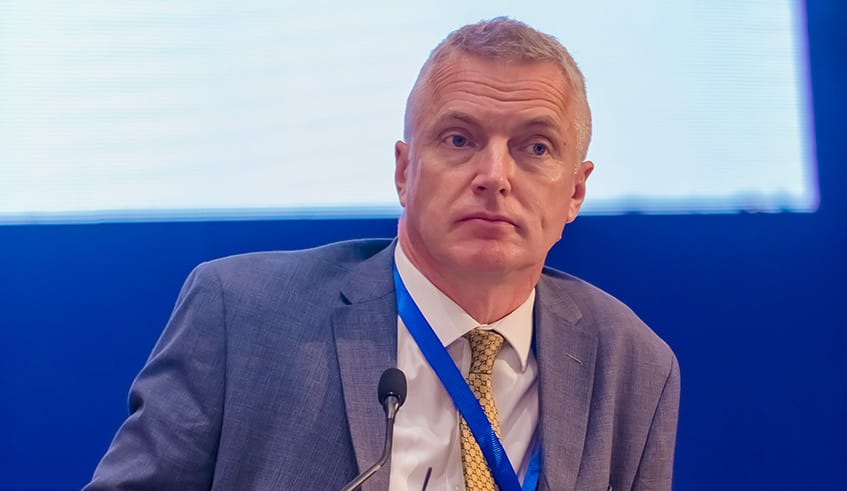- Africa Finance Today
- Posts
- How Rwanda could curtail rising public debt
How Rwanda could curtail rising public debt
Rwanda’s public debt has been rising rapidly since the Covid-19 pandemic.

Rwanda’s public debt has been rising rapidly since the Covid-19 pandemic. The ratio of public debt to gross domestic product (GDP) reached 66.6 per cent in June 2023 from 55 per cent in the same period in 2020.
Simply put, Rwanda has borrowed at least Rwf10.1 trillion as of June 2023, a 4.8 per cent increase from the year before.
The debt-to-GDP ratio has since increased further to 77.3 per cent as of end-June 2024, and is expected to accelerate and surpass the 80 per cent-mark by 2025, according to data from the Ministry of Finance and Economic Planning.
As of June 2024, 61.4 per cent of GDP was borrowed from foreign lenders. At least 75 per cent of that were multilateral creditors such as the International Monetary Fund (IMF), World Bank, European Investment Bank (EIB), African Development Bank (AfDB), and the Asia Investment Bank (AIB), to mention but a few.
In the same period, 12.2 per cent of Rwanda’s total debt stock was owed to bilateral creditors such as Export-Import Bank of China, while 12.8 per cent was owed to commercial lenders such as JP Morgan.
Only 16 per cent of the total public debt was borrowed domestically, and a big chunk of that – 70.4 per cent – were treasury debt securities such as bonds and treasury bills.
In its recent medium-term debt management strategy report, the Ministry of Finance attributed the rise in public debt to ambitious investments the government is pursuing to support the country's development agenda.

Rwanda has been borrowing to fund ambitious projects such as the expansion of Rwandair. Courtesy image.
It also credited the rise to the significant government interventions in response to the impact of several global challenges, including ongoing geo-political tensions, effects of Covid-19 pandemic, global inflation pressures, as well climate change disruptions.
The government started embracing higher borrowing at the height of Covid-19 to boost economic recovery and stimulate growth.
“Rwanda’s public debt to GDP ratio has been on an upward trajectory and it increasingly constrains the authorities’ ability to react to future shocks,” Gabor Pula, Resident Representative for the International Monetary Fund (IMF) in Rwanda told me.
However, Pula highlights that Rwanda's debt is less burdensome compared to many other countries in the region, as it primarily comprises low-interest loans from development partners rather than market-based financing.
Rwanda’s public debt to GDP ratio has been on an upward trajectory and it increasingly constrains the authorities’ ability to react to future shocks.
Likewise, Rwanda allocates a smaller share of its resources to debt servicing than its regional neighbors.

Gabor Pula, IMF Resident Coordinator for Rwanda. Courtesy image.
For example, Rwanda spends 30 per cent of its revenues on debt service, compared to Kenya’s and Uganda’s 60 per cent. Still, the upward trend of the current debt level is concerning, as it allows for less room to manoeuvre for the fiscal authorities, experts say.
“Given the highly volatile external environment going forward, it is important that the authorities have sufficient resources to react to future shocks, while at the same time advance the country’s ambitious development agenda,” Pula says.
The bottom line, experts say, debt needs to be reduced and that requires policy action.
Concessional borrowing declining
For many years, Rwanda preferred borrowing on concessional terms, typically finding lenders who offer better repayment terms, such as low interest rates, more grace periods, and long repayment periods.
This has meant that Rwanda has borrowed at less than 2 per cent, with long maturities of 30-40 years, and grace periods of 5-10 years, which has allowed government the space to gradually expand its tax base without pressure or fear of struggling to pay back.
However, concessional funding has been winding down.
According to the World Bank, its financing arm which offers concessional funding and grants, the International Development Association (IDA), has seen donor contributions decline over the past 20 years.
The situation is similar to other multilateral development banks (MDBs).
New donor contributions to the three largest concessional MDB arms – IDA, AfDF, and the Asian Development Fund (ADB) – have declined by 15 per cent in nominal terms over the last three replenishments, the World Bank shows.
This reality has made it difficult for countries like Rwanda to access concessional financing and grants. Data shows that whereas grants reached 6.9 per cent of Rwanda’s GDP in 2022, they declined to 4.7 per cent in 2023, and are forecast to decline further to just 3.2 per cent in 2025.
“Debt burdens are best and most effectively resolved through maintaining high rates of economic growth. That way, the denominator (GDP) expands and makes the debt burden more manageable,” says Andrew Mold, Acting Director of the Economic Commission for Africa (ECA) for Eastern Africa.
Mold criticises the IMF's current approach, noting that in the past, the organisation often recommended spending cuts to help countries balance their budgets.
Debt burdens are best and most effectively resolved through maintaining high rates of economic growth. That way, the denominator (GDP) expands and makes the debt burden more manageable.
“These days the IMF tends to prefer recommending raising taxes more to reduce the size of the fiscal deficit,” he explains. “The risk here is that if taxes are raised too much, it may have a negative impact on consumption and business activity.”
‘Review incentives’

Andrew Mold, Acting Director of the Economic Commission for Africa (ECA) for Eastern Africa. Internet Photo.
Angelo Musinguzi, former Senior Tax Manager at KPMG Rwanda, a consulting firm, observes that the government should rationalise public expenditure, and continue working on its domestic revenue.
“Corporate income tax (CIT) is not contributing much towards revenue generation because of many incentives granted by the government,” he argues, adding that incentives can be reduced.
The tax expert is convinced that the government currently offers generous CIT incentives, including a 50 per cent capital allowance, which comes in addition to standard asset depreciation.
Corporate income tax (CIT) is not contributing much towards revenue generation because of many incentives granted by the government.
A 50 per cent capital allowance means that businesses can deduct 50 per cent of the cost of qualifying assets from their taxable income in the first year of purchase. This leads to lower tax payments.
Investors also benefit from seven-year tax holidays.
“Instead of the standard 28% CIT rate, some investors enjoy preferential rates of 0%, 3%, or 15%, which could be re-evaluated for balance and impact,” Musinguzi notes.
Rwanda currently exempts value added tax (VAT), a key source of government revenue, on a long list of products and services.
Some education, transport, government projects, agriculture, health, as well as information and communication technology (ICT) goods and services, are all exempt from VAT.
To reduce debt, the authorities need to accelerate fiscal consolidation, IMF’s Pula suggests, asserting that fiscal consolidation has been progressing, but somewhat slower than expected.
This consolidation, he says, should be achieved through domestic revenue mobilisation, among other interventions.
“In Rwanda, tax revenues have been underperforming compared to the authorities’ projections. The tax to GDP ratio has been declining, which implies that taxes paid by some of the most dynamic sectors of the economy are not in par with the expansion of their businesses,” he notes.
These sectors are also the ones that benefit most from tax incentives.
According to the Rwanda Tax Expenditure report 2022-23, foregone revenues associated with these tax incentives have increased from 2.5 to 3.5 per cent of GDP in recent years.
“In our view, some of these tax incentives would need to be revisited and those that are not effective, would need to be withdrawn,” Pula says.
Reply